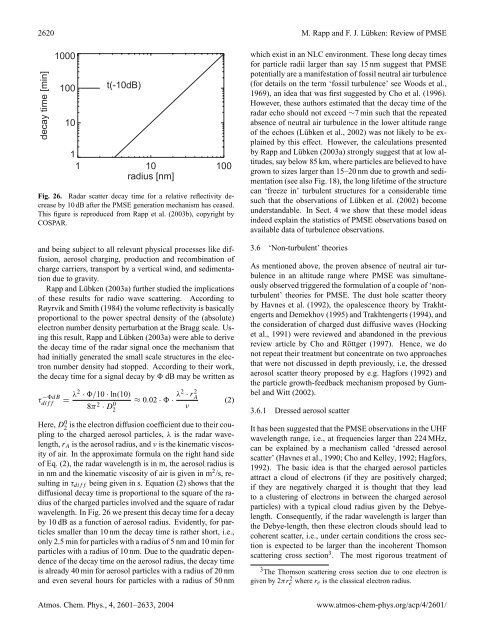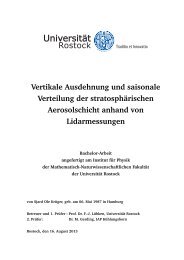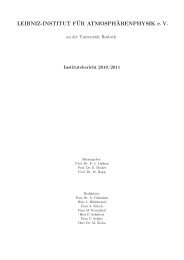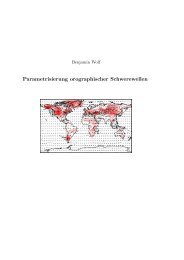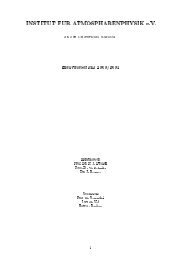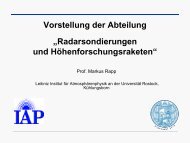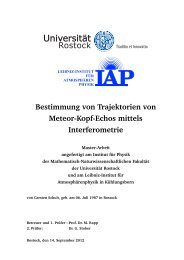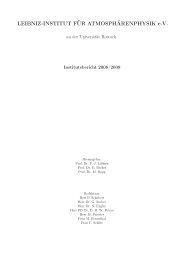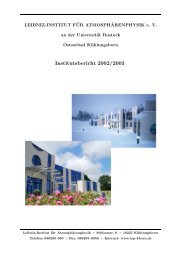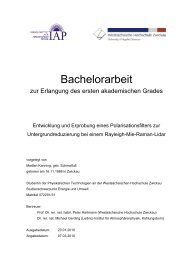Polar mesosphere summer echoes (PMSE): review of ... - HAL
Polar mesosphere summer echoes (PMSE): review of ... - HAL
Polar mesosphere summer echoes (PMSE): review of ... - HAL
Create successful ePaper yourself
Turn your PDF publications into a flip-book with our unique Google optimized e-Paper software.
2620 M. Rapp and F. J. Lübken: Review <strong>of</strong> <strong>PMSE</strong><br />
Fig. 26. Radar scatter decay time for a relative reflectivity decrease<br />
by 10 dB after the <strong>PMSE</strong> generation mechanism has ceased.<br />
This figure is reproduced from Rapp et al. (2003b), copyright by<br />
COSPAR.<br />
and being subject to all relevant physical processes like diffusion,<br />
aerosol charging, production and recombination <strong>of</strong><br />
charge carriers, transport by a vertical wind, and sedimentation<br />
due to gravity.<br />
Rapp and Lübken (2003a) further studied the implications<br />
<strong>of</strong> these results for radio wave scattering. According to<br />
Røyrvik and Smith (1984) the volume reflectivity is basically<br />
proportional to the power spectral density <strong>of</strong> the (absolute)<br />
electron number density perturbation at the Bragg scale. Using<br />
this result, Rapp and Lübken (2003a) were able to derive<br />
the decay time <strong>of</strong> the radar signal once the mechanism that<br />
had initially generated the small scale structures in the electron<br />
number density had stopped. According to their work,<br />
the decay time for a signal decay by dB may be written as<br />
τ −dB<br />
diff<br />
= λ2 · /10 · ln(10)<br />
8π 2 · D 0 2<br />
≈ 0.02 · · λ2 · r 2 A<br />
ν<br />
Here, D2 0 is the electron diffusion coefficient due to their coupling<br />
to the charged aerosol particles, λ is the radar wavelength,<br />
r A is the aerosol radius, and ν is the kinematic viscosity<br />
<strong>of</strong> air. In the approximate formula on the right hand side<br />
<strong>of</strong> Eq. (2), the radar wavelength is in m, the aerosol radius is<br />
in nm and the kinematic viscosity <strong>of</strong> air is given in m 2 /s, resulting<br />
in τ diff being given in s. Equation (2) shows that the<br />
diffusional decay time is proportional to the square <strong>of</strong> the radius<br />
<strong>of</strong> the charged particles involved and the square <strong>of</strong> radar<br />
wavelength. In Fig. 26 we present this decay time for a decay<br />
by 10 dB as a function <strong>of</strong> aerosol radius. Evidently, for particles<br />
smaller than 10 nm the decay time is rather short, i.e.,<br />
only 2.5 min for particles with a radius <strong>of</strong> 5 nm and 10 min for<br />
particles with a radius <strong>of</strong> 10 nm. Due to the quadratic dependence<br />
<strong>of</strong> the decay time on the aerosol radius, the decay time<br />
is already 40 min for aerosol particles with a radius <strong>of</strong> 20 nm<br />
and even several hours for particles with a radius <strong>of</strong> 50 nm<br />
(2)<br />
which exist in an NLC environment. These long decay times<br />
for particle radii larger than say 15 nm suggest that <strong>PMSE</strong><br />
potentially are a manifestation <strong>of</strong> fossil neutral air turbulence<br />
(for details on the term ‘fossil turbulence’ see Woods et al.,<br />
1969), an idea that was first suggested by Cho et al. (1996).<br />
However, these authors estimated that the decay time <strong>of</strong> the<br />
radar echo should not exceed ∼7 min such that the repeated<br />
absence <strong>of</strong> neutral air turbulence in the lower altitude range<br />
<strong>of</strong> the <strong>echoes</strong> (Lübken et al., 2002) was not likely to be explained<br />
by this effect. However, the calculations presented<br />
by Rapp and Lübken (2003a) strongly suggest that at low altitudes,<br />
say below 85 km, where particles are believed to have<br />
grown to sizes larger than 15–20 nm due to growth and sedimentation<br />
(see also Fig. 18), the long lifetime <strong>of</strong> the structure<br />
can ‘freeze in’ turbulent structures for a considerable time<br />
such that the observations <strong>of</strong> Lübken et al. (2002) become<br />
understandable. In Sect. 4 we show that these model ideas<br />
indeed explain the statistics <strong>of</strong> <strong>PMSE</strong> observations based on<br />
available data <strong>of</strong> turbulence observations.<br />
3.6 ‘Non-turbulent’ theories<br />
As mentioned above, the proven absence <strong>of</strong> neutral air turbulence<br />
in an altitude range where <strong>PMSE</strong> was simultaneously<br />
observed triggered the formulation <strong>of</strong> a couple <strong>of</strong> ‘nonturbulent’<br />
theories for <strong>PMSE</strong>. The dust hole scatter theory<br />
by Havnes et al. (1992), the opalescence theory by Trakhtengerts<br />
and Demekhov (1995) and Trakhtengerts (1994), and<br />
the consideration <strong>of</strong> charged dust diffusive waves (Hocking<br />
et al., 1991) were <strong>review</strong>ed and abandoned in the previous<br />
<strong>review</strong> article by Cho and Röttger (1997). Hence, we do<br />
not repeat their treatment but concentrate on two approaches<br />
that were not discussed in depth previously, i.e, the dressed<br />
aerosol scatter theory proposed by e.g. Hagfors (1992) and<br />
the particle growth-feedback mechanism proposed by Gumbel<br />
and Witt (2002).<br />
3.6.1 Dressed aerosol scatter<br />
It has been suggested that the <strong>PMSE</strong> observations in the UHF<br />
wavelength range, i.e., at frequencies larger than 224 MHz,<br />
can be explained by a mechanism called ‘dressed aerosol<br />
scatter’ (Havnes et al., 1990; Cho and Kelley, 1992; Hagfors,<br />
1992). The basic idea is that the charged aerosol particles<br />
attract a cloud <strong>of</strong> electrons (if they are positively charged;<br />
if they are negatively charged it is thought that they lead<br />
to a clustering <strong>of</strong> electrons in between the charged aerosol<br />
particles) with a typical cloud radius given by the Debyelength.<br />
Consequently, if the radar wavelength is larger than<br />
the Debye-length, then these electron clouds should lead to<br />
coherent scatter, i.e., under certain conditions the cross section<br />
is expected to be larger than the incoherent Thomson<br />
scattering cross section 3 . The most rigorous treatment <strong>of</strong><br />
3 The Thomson scattering cross section due to one electron is<br />
given by 2πr 2 e where r e is the classical electron radius.<br />
Atmos. Chem. Phys., 4, 2601–2633, 2004<br />
www.atmos-chem-phys.org/acp/4/2601/


